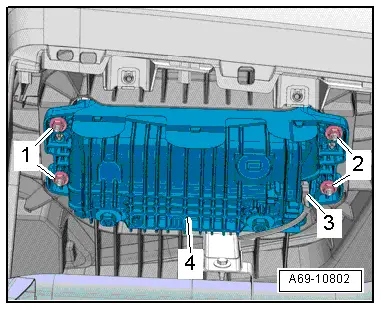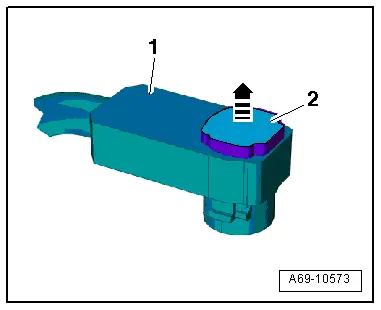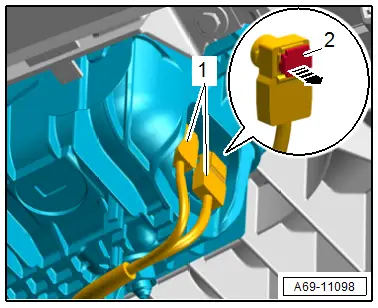Audi Q3: Front Passenger Airbag
Overview - Front Passenger Airbag

1 - Front Passenger Airbag
- With Front Passenger Airbag Igniter 1 -N131-
 WARNING
WARNING
- Follow all safety precautions when working with pyrotechnic components. Refer to → Chapter "Pyrotechnic Components Safety Precautions".
- Follow the allocation of the airbag unit to the instrument panel. Refer to the Parts Catalog.
- Removing and installing. Refer to → Chapter "Front Passenger Airbag Unit with Igniter, Removing and Installing".
2 - Nut
- 9 Nm
- Replace
3 - Instrument Panel
- Replace the instrument panel after an airbag has deployed. Refer to → Chapter "Instrument Panel, Removing and Installing".
4 - Connector
- For Front Passenger Airbag Igniter 1 -N131-
5 - Nut
- 9 Nm
- Replace
6 - Connector
- USA and Canada market-specific for Front Passenger Airbag Igniter 2 -N132-
7 - Connector
- USA and Canada market-specific for Front Passenger Airbag Igniter 1 -N131-
8 - Front Passenger Airbag
- USA and Canada market-specific with Front Passenger Airbag Igniter 1 -N131- and Front Passenger Airbag Igniter 2 -N132-
 WARNING
WARNING
- Follow all safety precautions when working with pyrotechnic components. Refer to → Chapter "Pyrotechnic Components Safety Precautions".
- Follow the allocation of the airbag unit to the instrument panel. Refer to the Parts Catalog.
- Removing and installing. Refer to → Chapter "Front Passenger Airbag Unit with Igniter, Removing and Installing".
Front Passenger Airbag Unit with Igniter, Removing and Installing
Removing
 WARNING
WARNING
- Follow all safety precautions when working with pyrotechnic components. Refer to → Chapter "Pyrotechnic Components Safety Precautions".
- Follow all regulations when disposing of pyrotechnic components. Refer to → Chapter "Airbag, Belt Tensioner and Battery Cut-Out Units, Storing, Transporting and Disposing".
- Follow the allocation of the airbag unit to the instrument panel. Refer to the Parts Catalog.
- Disconnect the battery ground cable with the ignition turned on. Refer to → Electrical Equipment; Rep. Gr.27; Battery; Battery, Disconnecting and Connecting.
- Remove the glove compartment. Refer to → Chapter "Glove Compartment, Removing and Installing".
 WARNING
WARNING
Before handling pyrotechnic components (for example, disconnecting the connector), the person handling it must "discharge static electricity". This can be done by touching the door striker, for example.
- Disconnect the connector -3- from the Front Passenger Airbag Igniter 1 -N131-.

- To do so, release the connector lock -2- with a small screwdriver -arrow- and disconnect the connector -1-.

USA and Canada market versions:
 WARNING
WARNING
Before handling pyrotechnic components (for example, disconnecting the connector), the person handling it must "discharge static electricity". This can be done by touching the door striker, for example.
- Release the connector lock -2- with a small screwdriver -arrow-.
- Disconnect the connector -1- on the Front Passenger Airbag Igniter 1 -N131- and Front Passenger Airbag Igniter 2 -N132-.

Continuation for all vehicles:
 WARNING
WARNING
Secure the airbag unit from falling.
- Remove the nuts -1 and 2-.
- Remove the passenger airbag -4- downward.

 WARNING
WARNING
Set the airbag down so the impact cushion faces upward.
Installing
 WARNING
WARNING
- Follow all safety precautions when working with pyrotechnic components. Refer to → Chapter "Pyrotechnic Components Safety Precautions".
- Before handling pyrotechnic components (for example, connecting the connector), the person handling it must "discharge static electricity". This can be done by touching the door striker, for example.
- Follow the allocation of the airbag to the instrument panel. Refer to the Parts Catalog.
Install in reverse order of removal. Note the following:
 Note
Note
- Make sure the connectors are installed correctly and are secure.
- Make sure the wires do not get caught.
 WARNING
WARNING
Ignition must be on when connecting battery. If pyrotechnic components (for example, airbag, belt tensioner) are not repaired correctly, they may deploy unintentionally after connecting battery. There must not be anyone inside the vehicle when connecting the battery.
- Connect the battery ground cable with the ignition turned on. Refer to → Electrical Equipment; Rep. Gr.27; Battery; Battery, Disconnecting and Connecting.
 Note
Note
If the Airbag Indicator Lamp -K75- signals a fault after installing, check the DTC memory, erase it and check it again. Refer to Vehicle Diagnostic Tester.
Installation notes, for example tightening specifications, replacing components. Refer to → Chapter "Overview - Front Passenger Airbag".
Front Passenger Airbag Deactivation Key Switch, Removing and Installing
NOT FOR NORTH AMERICAN MARKET
Removing
 WARNING
WARNING
Follow all safety precautions when working with pyrotechnic components. Refer to → Chapter "Pyrotechnic Components Safety Precautions".
- Disconnect the battery ground cable with the ignition turned on. Refer to → Electrical Equipment; Rep. Gr.27; Battery; Battery, Disconnecting and Connecting.
- Remove the glove compartment. Refer to → Chapter "Glove Compartment, Removing and Installing".
 WARNING
WARNING
Before handling pyrotechnic components (for example, disconnecting the connector), the person handling it must "discharge static electricity". This can be done by touching the door striker, for example.
- Press the catch -1- in -the direction of the arrow- until the connector disengages.
- Disconnect the connector -2-.
- Release the springs -3- and -5- and push the Front Passenger Airbag Deactivation Key Switch -E224--item 4- out of the key switch housing.

Installing
 WARNING
WARNING
- Follow all safety precautions when working with pyrotechnic components. Refer to → Chapter "Pyrotechnic Components Safety Precautions".
- Before handling pyrotechnic components (for example, connecting the connector), the person handling it must "discharge static electricity". This can be done by touching the door striker, for example.
Install in reverse order of removal. Note the following:
 Note
Note
- Make sure the connectors are installed correctly and are secure.
- Make sure the wires do not get caught.
- Make sure the Front Passenger Airbag Deactivation Key Switch -E224- clicks into the housing.
 WARNING
WARNING
Ignition must be on when connecting battery. If pyrotechnic components (for example, airbag, belt tensioner) are not repaired correctly, they may deploy unintentionally after connecting battery. There must not be anyone inside the vehicle when connecting the battery.
- Connect the battery ground cable with the ignition turned on. Refer to → Electrical Equipment; Rep. Gr.27; Battery; Battery, Disconnecting and Connecting.
 Note
Note
If the Airbag Indicator Lamp -K75- signals a fault after installing, check the DTC memory, erase it and check it again. Refer to → Vehicle diagnostic tester.
Installation notes, for example tightening specifications, replacing components. Refer to → Chapter "Overview - Glove Compartment".

